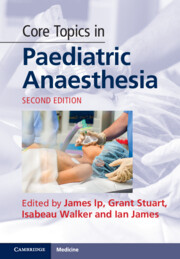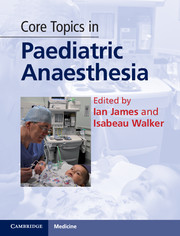21 results

Core Topics in Paediatric Anaesthesia
- Coming soon
-
- Expected online publication date:
- September 2024
- Print publication:
- 30 September 2024
-
- Book
- Export citation
Chapter 20 - General Principles and Conduct of Paediatric Cardiac Anaesthesia
- from Section 4 - Paediatric Cardiac Surgery
-
-
- Book:
- Core Topics in Cardiac Anaesthesia
- Published online:
- 12 May 2020
- Print publication:
- 23 April 2020, pp 145-153
-
- Chapter
- Export citation
Section IV - The critically ill child
-
- Book:
- Core Topics in Paediatric Anaesthesia
- Published online:
- 05 August 2013
- Print publication:
- 04 July 2013, pp 377-437
-
- Chapter
- Export citation
Contents
-
- Book:
- Core Topics in Paediatric Anaesthesia
- Published online:
- 05 August 2013
- Print publication:
- 04 July 2013, pp v-vi
-
- Chapter
- Export citation
Preface
-
-
- Book:
- Core Topics in Paediatric Anaesthesia
- Published online:
- 05 August 2013
- Print publication:
- 04 July 2013, pp vii-vii
-
- Chapter
- Export citation
Section I - Introduction
-
- Book:
- Core Topics in Paediatric Anaesthesia
- Published online:
- 05 August 2013
- Print publication:
- 04 July 2013, pp 1-50
-
- Chapter
- Export citation
Chapter 9 - The premature and ex-premature infant
- from Section II - Peri-operative period: general principles
-
-
- Book:
- Core Topics in Paediatric Anaesthesia
- Published online:
- 05 August 2013
- Print publication:
- 04 July 2013, pp 79-85
-
- Chapter
- Export citation
Chapter 14 - Peri-operative fluid management in children
- from Section II - Peri-operative period: general principles
-
-
- Book:
- Core Topics in Paediatric Anaesthesia
- Published online:
- 05 August 2013
- Print publication:
- 04 July 2013, pp 132-143
-
- Chapter
- Export citation
Contributors
-
-
- Book:
- Core Topics in Paediatric Anaesthesia
- Published online:
- 05 August 2013
- Print publication:
- 04 July 2013, pp viii-x
-
- Chapter
- Export citation
Index
-
- Book:
- Core Topics in Paediatric Anaesthesia
- Published online:
- 05 August 2013
- Print publication:
- 04 July 2013, pp 438-456
-
- Chapter
- Export citation
Core Topics in Paediatric Anaesthesia - Title page
-
-
- Book:
- Core Topics in Paediatric Anaesthesia
- Published online:
- 05 August 2013
- Print publication:
- 04 July 2013, pp iii-iii
-
- Chapter
- Export citation
Chapter 1 - Anatomical and physiological issues affecting anaesthesia in neonates and young children
- from Section I - Introduction
-
-
- Book:
- Core Topics in Paediatric Anaesthesia
- Published online:
- 05 August 2013
- Print publication:
- 04 July 2013, pp 1-9
-
- Chapter
- Export citation
Core Topics in Paediatric Anaesthesia - Half title page
-
- Book:
- Core Topics in Paediatric Anaesthesia
- Published online:
- 05 August 2013
- Print publication:
- 04 July 2013, pp i-ii
-
- Chapter
- Export citation
Chapter 37 - Anaesthesia for oncology and other medical procedures in children
- from Section III - Clinical anaesthesia: specialty considerations
-
-
- Book:
- Core Topics in Paediatric Anaesthesia
- Published online:
- 05 August 2013
- Print publication:
- 04 July 2013, pp 366-376
-
- Chapter
- Export citation
Copyright page
-
- Book:
- Core Topics in Paediatric Anaesthesia
- Published online:
- 05 August 2013
- Print publication:
- 04 July 2013, pp iv-iv
-
- Chapter
- Export citation
Section III - Clinical anaesthesia: specialty considerations
-
- Book:
- Core Topics in Paediatric Anaesthesia
- Published online:
- 05 August 2013
- Print publication:
- 04 July 2013, pp 191-376
-
- Chapter
- Export citation

Core Topics in Paediatric Anaesthesia
-
- Published online:
- 05 August 2013
- Print publication:
- 04 July 2013
Section II - Peri-operative period: general principles
-
- Book:
- Core Topics in Paediatric Anaesthesia
- Published online:
- 05 August 2013
- Print publication:
- 04 July 2013, pp 51-190
-
- Chapter
- Export citation
Contributors
-
-
- Book:
- Core Topics in Cardiac Anesthesia
- Published online:
- 05 April 2012
- Print publication:
- 15 March 2012, pp x-xiii
-
- Chapter
- Export citation
Chapter 49 - General principles
- from Section 8 - Pediatric cardiac anesthesia
-
-
- Book:
- Core Topics in Cardiac Anesthesia
- Published online:
- 05 April 2012
- Print publication:
- 15 March 2012, pp 303-306
-
- Chapter
- Export citation



